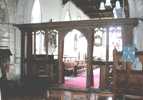 Bunny Bunny
St Mary
History
The Saxons made a settlement here and called it Bune which is an old English
term for a reed. It has also been called Bonei or Boneya, and Thoroton referred
to it in 1677 as Boney. It is spelt as Bunney on a memorial
in 1741 and on
others of later date, but including one of 1725, it is Bunny.
The first overlord in the time of Edward the Confessor (1042-1066) was called
Levenot. There was a church, a priest, and land for six ploughs. Fitzherbert
was successor to Levenot and he let the foundation of the land to Lenton Priory.
In 1225 Anker de Boneya added to this gift. After the death of one of the latter’s
family the manor passed to the Freshvilles. Anker de Freshville forfeited his
possessions by taking part with the barons against the King in 1264. As a result,
Bunny became Crown property. A heavy fine was imposed for its redemption and
Anker died before it was paid in full.
In 1323-24 the Chapter of Southwell appropriated
the Church of Bunny to make a chantry for the soul of William, Archbishop of York,
but in 1346 it was claimed by the Priory of Ulverscroft. The manor subsequently
passed into the possession of the families of Belers de Swillington (by marriage
with Margaret Belers) and Grey (by marriage with the widowed Margaret Swillington
in 1420). Richard de Cromwell, a cousin of Margaret, established his right
to the property in 1460, and in 1461 he passed it to the Illingworths.
In 1504 Richard Illingworth died leaving four daughters. His daughter Joan
married George Barlowe of Stoke. Their son Thomas married Dorothy Mavenell
and their son Humphrey Barlowe married Elizabeth daughter of Adam Beresford
of Fenny Bentley Derbyshire. Humphrey Barlowe died in 1570 and his widow, Elizabeth
Barlowe, married Richard Parkyns. Humphrey Barlowe’s memorial stone is
the oldest monument in Bunny Church. Of the families
who owned Bunny Hall, the Parkyns were the most influential.
Sir Thomas Parkyns (1663-1741), the second baronet, was perhaps the most famous
of all the Parkyns. He was an eccentric whose many interests ranged from architecture
and mathematics to Latin grammar and the art of Cornish wrestling. He designed
and built Bunny Hall and Park, as well as a vicarage and the old school. He
gave two bells to the church, and had the chancel and nave re-roofed about
1718. The chancel roof must have been considerably lowered. The east window is square headed and all the tracery from the upper part was probably removed
at this time.
 The
screen The
screen |
Sir Stephen Glynne described Bunny as ‘a handsome village church, comprising
a nave with aisles, a large Chancel and Western tower with lofty spire, and
south porch.’ He noted that ‘the chancel is very large and fine – nearly
equal in length to the nave. There is a rood
screen of 3 divisions.’ He
evidently liked the church but resisted the temptation to be too effusive.
Further renovations occurred about 1887 when the old pews were taken out and
replaced by chairs. At the same time the west gallery was removed, together
with the fire place and chimney in the Hall pew, which ran along the north
wall of the chancel. A vertical lane of soot is still visible from bottom to
top of the north wall of the chancel. This would be the place of the chimney
to the Parkyn’s fireplace removed in 1887.
In 1914 Bishop Hoskyns visited the church and noted the need for a mission
church at Bradmore. The statistics collected for his Visitation indicated that
there had been a mission church there in 1887. Seventy-nine children were enrolled
with the church school in Bunny and 61 with the Sunday School. There were three
baptisms and 11 confirmations in the year to September 1912.
During the time of the Rev J F Kahn (vicar 1920-33), electricity was
installed in the church, a carpet provided and the heating apparatus was repaired.
Mr Kahn sold the glebe land in 1921 and the proceeds went to the Church Commissioners.
During alterations in 1955 a new High Altar was installed.
The parish registers date from 1556. Thoroton states that in the first five years
of the register 95 baptisms and 85 burials were recorded. The first register
records events from 1556-1723, and the second, now lost, from 1723-1802. A further
register covers 1802-12. The Registers include entries for both Bunny and Bradmore.
| 


 The
screen
The
screen





